Valleys and mountains. Alpine refuges and ski resorts. Glorious forests. Flocks of birds. Fertile soil, endless tobacco plantations. 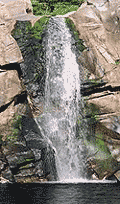 Caves with enormous multicoloured stalactites. Rivers that burble gently. Lyrical waters.
Caves with enormous multicoloured stalactites. Rivers that burble gently. Lyrical waters.  Magical scenery. Hospitable people with warm smiles.
Magical scenery. Hospitable people with warm smiles.
The prefectural capital bears the same name, Drama. It lies at the foot of Mt. Falakro, which the locals call “the mountain of the flowers”.
This mountain of remarkable beauty boasts ski slopes for winter sports enthusiasts and four well-equipped refuges for climbers.
The town, drenched in greenery and flowers thanks to its abundant water, looms above the valley filled with tobacco fields as far as the eye can see.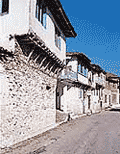
Why not take a hike through the wonderful forest of Elatia (70 km. north of Drama), where amongst the pines, oaks and willows, the red fir grows, a very rare tree in this country whose height often reaches 50 meters.
Southeast of Drama (10km.) is the pretty market town of Doxato, with facilities for tourists and a reputation for fun and high spirits.
The Bounar-Bassi springs, a corner of Paradise with running streams and enormous trees, are just 3 kilometers away at the foot of Kouslari, a low mountain.
City of Drama
At the archaeological museum which lies close to the Public Park, an area full of greenery and running water, the visitor can find information on the history of Drama from prehistoric times up to the period of Turkish occupation and the inter-war years all gathered in one place.
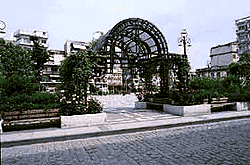 The Ayia Barbara park covers approximately 60,000 m2 and throughout time has been an identifying feature of the city and a pole of attraction for tourists. Here one can clearly see the city's wealth in running water as well as much of the more recent history of Drama. Water springs up from various points forming small lakes and waterfalls under the shade of ancient trees. In some places the water creates impressive sounds, in others it flows calmly and quietly as it branches out and covers the whole park.
The Ayia Barbara park covers approximately 60,000 m2 and throughout time has been an identifying feature of the city and a pole of attraction for tourists. Here one can clearly see the city's wealth in running water as well as much of the more recent history of Drama. Water springs up from various points forming small lakes and waterfalls under the shade of ancient trees. In some places the water creates impressive sounds, in others it flows calmly and quietly as it branches out and covers the whole park. One can see traditional watermills here and multi-storey tobacco storehouses from the inter-war years ret1ected in the calm waters and in the depths of the lake are the remains of an Orthodox church. The Mill of Zonke stands out from all the other mills, which are located at the south side of the park. In the north side of the park lies a multi-storey tobacco storehouse which dates from 1925 and recalls the golden age of the city when hundreds of workers filled the halls of the tobacco factories and produced tobacco of the highest quality. Exactly in front of it are the ruins of the Joseph Faratzis tobacco storehouse where the Jews from Drama were imprisoned in 1943 before their tragic end in the Polish concentration camps. A monument in their honour stands in the centre of the park. Around this monument are houses from past times which have been declared national monuments.
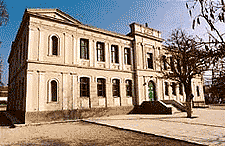 A special day in the park is the eve of the feast day of the city's patron saint, Ayia Barbara, held on the 3rd of December, when hundreds of children leave small boats lit up on the calm waters of the lake, providing those present with a wonderful sight in the twilight.
A special day in the park is the eve of the feast day of the city's patron saint, Ayia Barbara, held on the 3rd of December, when hundreds of children leave small boats lit up on the calm waters of the lake, providing those present with a wonderful sight in the twilight.The Cathedral of Drama stands part of the old Cathedral of the Presentation of the Virgin built in1834 by Bishop Philippos Germanos which contains exceptional works of woodcarving inside dating too from the 19th century. Exactly opposite the Cathedral are the restored building of the old city cinema, the one time "Mega" dating from 1913 and town houses from the beginning of the 20th century.
A short distance from the cinema lies the Byzantine church of Ayia Sofia dating from the l0th century. The church was remodelled during Byzantine years as well as during the Turkish occupation when it was converted into a mosque.
In the same area, one can go in search of the remains of the city's Byzantine walls. Among modem town houses dating from the inter-war years one can find the remains of six towers from the walls which in total covered a length of roughly 850rn and an area of approximately 40,000 m2.
The Byzantine Chapel of the Archangels dating from the period of the Paleologian emperors is a single-aisled basilica, which leans up against the Byzantine walls near the eastern gate to the city. On the side of the church there is an impressive upside-down latin inscription embedded in the wall while inside the church there are wall paintings from the cycle of the Passions of Christ with the Archangels and the forms of two hierarchs in the conch of the Saturday.
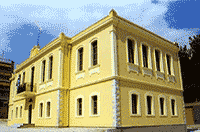 The modern commercial centre of Drama has well-preserved narrow streets. At the junction of Armen St. and Agamemnon lies a mosque, with noteworthy wall paintings on its northern side which depict the city of Drama during the period of Turkish occupation.
The modern commercial centre of Drama has well-preserved narrow streets. At the junction of Armen St. and Agamemnon lies a mosque, with noteworthy wall paintings on its northern side which depict the city of Drama during the period of Turkish occupation. If one makes the short excursion to the north of the city one can visit the hill of Korylovo which is a point of reference for the city. Nature lovers can enjoy a walk and get some exercise at any time of the year among the pine forest which cover the slopes of the hill. After driving or climbing 4km to the peak which lies at an altitude of 600m the visitor will be greeted with a panoramic view of the whole of the lowlands of Drama and the surrounding mountains. There visitors will find places to relax and to exercise at the place.
The city of Drama today with its 40,000 residents, apart from being an economic and commercial centre with the opportunity to promote its products at an important annual commercial exhibition, is a hive of cultural and athletic activity. Every year there are literary and artistic events held here with many exhibitions with artists from other Balkan countries. At the end of June, residents and guest artists participate in the city festivities known as the Eleftheria, the most characteristic event being the well-established choir meeting.
In a city where football is loved thanks to the historical team "Doxa Dramas" and in which volleyball, basketball and hockey are fast-growing sports, athletics is a way of life for many. Sports fans can work out and train in facilities such as the National Stadium or enjoy peaceful walks on Korylovo among the pines or in the city's parks. Moreover there are municipal facilities for tennis and private facilities for mini football and places on Korylovo where one can learn or practice gliding.
There are go-kart facilities too, in the east of the city. It is nightlife, though, that Drama is particularly renowned for as the people of the city are famous for their joie de vivre and their talent in both song and dance. Beginning in the taverns which offer traditional and local dishes, or the city's coffee shops with their distinct sense of finesse, one can get to know a little of the intense night life in the city either in open air summer places or winter venues which offer a wide range of fun things for the visitor to choose from regardless of age.

